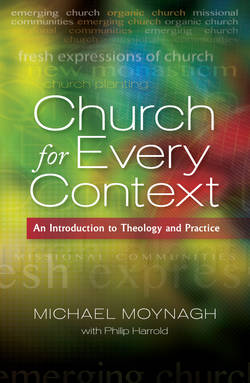Читать книгу Church for Every Context - Michael Moynagh - Страница 18
На сайте Литреса книга снята с продажи.
An outline of the book
ОглавлениеChurch for Every Context argues that as part of recent theology’s turn to the church, we should affirm the God-given role of the church as a visible community in all the contexts of life, that methodologies for practising this are beginning to emerge and that the denominations should make new contextual church a priority. The book is in four parts. The first puts new contextual churches into a historical and contemporary context. It shows how the church reproduced in the New Testament, how it has regularly done so since, how in Britain (as in other countries) it is learning to reproduce in fresh ways today and why these new forms of reproduction are sociologically significant.
Against this background, Part 2 offers some theological foundations for contextual church. Chapter 5 asks whether these communities can be properly called church: what is the essential nature of the church and how might we understand maturity in relation to new contextual churches? Chapter 6 maintains that mission should be a first step for the church. Chapter 7 argues that this mission should take communal form in the different places where people now lead their lives. Chapter 8 contends that these communal forms of mission should be thoroughly contextual, while remaining true to Jesus. Chapter 9 argues that being contextual will mean focusing on specific cultures. It suggests that this is consistent with the New Testament vision of a diverse but united church. Chapter 10 claims that these contextual churches are faithful to the Christian tradition.
Part 3 builds on the theology of the earlier chapters. It argues that founding new churches should be viewed as an essential Christian practice, which is beginning to be expressed in new ways. As the beginning of a contemporary description of this practice, Chapter 11 describes what it means for mission to take communal form in the many settings of society. As a crucial step toward this communal expression of mission, Chapter 12 discusses the process of gathering a mission community (the founding team of the new church). Chapters 13 and 14 describe how this mission community can begin to engage in contextual mission – by researching opportunities to serve the context and engaging with potential partners. Chapters 15 and 16 describe two processes – action-based learning and what I have called team awareness – that support the gathering, researching and engaging activities.
Part 4 is about laying down pathways to maturity. It describes the outlines of four such pathways – making disciples, worship, community and sustainability. It points to some of the directions of travel, recognizing that we still have much to learn about the stepping stones within each pathway.
The final chapter argues that contextual churches should grow to maturity within the setting of a mixed-economy church, in which new forms of church and inherited church (churches with inherited structures and patterns of life) exist alongside each other in relationships of mutual support. The book can be read as an extended argument for the mixed economy. New contextual churches are theologically well founded. We are learning how to practise them. This learning should continue within a mixed-economy setting.
In organizing the chapters, I have tried to respond to pleas that training for church founders integrate theory and practice (Croft, 2008a, p. 49). Thus a number of chapters are designed to build bridges between the practice of contextual church and specific academic disciplines. The disciplines include Old Testament (Chapter 19), New Testament (Chapter 1), systematic theology (especially Chapters 5, 6 and 21), church history (Chapters 2 and 10), worship (Chapter 18) and, of course, themes within mission studies such as sociology (Chapter 4), contextualization (Chapters 5 and 6) and evangelism (Chapters 12 and 18).
